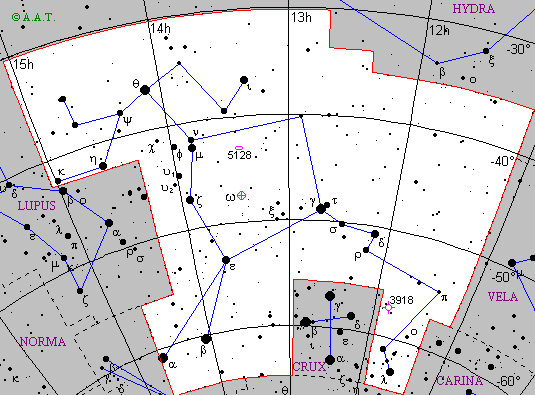 |
 |
| English name | Centaur | ||||
|---|---|---|---|---|---|
| Stelle maggiori | alpha Centauri | Rigil | magn. -0,3 | RA: 14h 39m 37.24s | Dec: -60° 50' 08.8" |
| beta Centauri | Hadar | magn. 0,6 | RA: 14h 03m 49.47s | Dec: -60° 22' 22.7" | |
| gamma Centauri | magn. 2,3 | RA: 12h 41m 31.05s | Dec: -48° 57' 34.7" | ||
| delta Centauri | magn. 2,8 | RA: 12h 08m 21.54s | Dec: -50° 43' 20.8" | ||
| epsilon Centauri | magn. 2,5 | RA: 13h 39m 53.29s | Dec: -53° 27' 58.7" | ||
| zeta Centauri | magn. 3,0 | RA: 13h 55m 32.39s | Dec: -47° 17' 17.9" | ||
| eta Centauri | magn. 2,5 | RA: 14h 35m 30.44s | Dec: -42° 09' 28.0" | ||
| theta Centauri | Menkent | magn. 2,2 | RA: 14h 06m 41.05s | Dec: -36° 22' 11.0" | |
| iota Centauri | magn. 2,8 | RA: 13h 20m 35.90s | Dec: -36° 42' 44.1" | ||
| kappa Centauri | magn. 3,4 | RA: 14h 59m 09.70s | Dec: -42° 06' 15.2" | ||
| lambda Centauri | magn. 3,3 | RA: 11h 35m 46.83s | Dec: -63° 01' 11.1" | ||
| my Centauri | magn. 3,3 | RA: 13h 49m 37.02s | Dec: -42° 28' 25.7" | ||
| ny Centauri | magn. 3,5 | RA: 13h 49m 30.32s | Dec: -41° 41' 15.8" | ||
| Description | Very shining and big constellation, situated to the south of Virgo. Centaurus contains the nearest star to the Sun, alpha Centauri, which is 4,3 light-years away from us: with its magnitude -0,3 it sets itself at the third place among the stars in order of brightness. Alpha Centauri is a double constituted by two yellow stars of magnitude 0,0 and 1,4, that orbit round each other with an 80-year period. To be precise, there is a third companion, a red dwarf of eleventh magnitude, which is really the nearest star to the Sun: it is, in fact, 4,2 light-years away from the solar system; it is called Proxima Centauri.
A particular galaxy is NGC 5128, known as radio source Centaurus A. It is a big elliptical galaxy, cut by a band of dark dusts: it is probably the collision between an elliptical galaxy and a spiral. NGC 5128 is one of the strongest radio-wave sources, with two emission points located on the two sides of the galaxy. It is situated at a distance of 15 million light-years. |
||||
| Mythology and history | The constellation represents Chiron, one of the centaurs; the centaurs were fantastic animals, half men and half horses, ignorant and savage. Chiron, however, since he was child of the god Chronus, was different from his other likes: he was wise and kind, versed in medicine and in a lot of other arts, particularly in music. He was friend of Apollo, who taught him the archery, and he was the preceptor of many heroes, among whom there were Hercules and Aesculapius (respectively represented in the constellations of Hercules and Ophiuchus). Chiron was immortal. But when Hercules attached the other centaurs with his poisoned arrows, one of the darts accidentally stroke Chiron, who, not able to bear the pain, asked Zeus to remove his immortality. The king of the gods granted his supplication, giving him in exchange a place among the stars. |
||||
 Back to constellations page.
Back to constellations page.